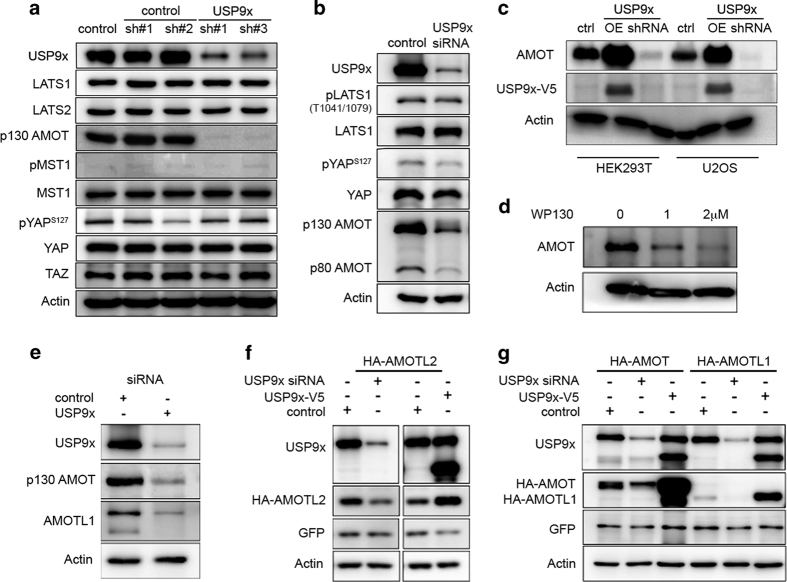Figure 2.
USP9x regulates AMOT levels. (a) Immunoblots of HEK293T cells transfected with shRNAs to deplete USP9x or with control shRNAs or with an empty vector control. Blots were probed with the indicated antibodies. Anti-USP9x was directed to the C terminus of the protein and recognizes the full length protein. Anti-Actin was used to control for loading. Note the low level of p130AMOT in USP9x-depleted cells. (b) Immunoblots of HEK293T cells transfected with a pool of siRNAs to deplete USP9x or with control siRNAs and probed with the indicated antibodies. (c) Immunoblots of HEK293T and U2OS cells transfected to express HA-tagged AMOT p130 together with V5-tagged USp9x (OE) or with a pool of shRNAs to deplete USP9x. Blots were probed with anti-HA to detect AMOT, anti-V5 to detect USP9x and anti-Actin as a loading control. (d) Immunoblots of HEK293T cells treated with the DUB inhibitor WP130 at the indicated concentrations. Blots were probed with endogenous AMOT and with anti-Actin as a loading control. (e) Immunoblots of HEK293T cells transfected with a pool of siRNAs to deplete USP9x or with control siRNAs and probed with antibodies to p130AMOT and USP9x (C terminus). (f, g) Immunoblots of HEK293T cells transfected to express HA-tagged p130-AMOT, AMOT-L1 or AMOT-L2 together with a pool of shRNAs to deplete USP9x or with V5-tagged USp9x (or empty vector control). Blots were probed with anti-HA to detect the AMOT family proteins, with anti-USP9x and with anti-Actin as a loading control. Antibody to the N terminus of USP9x detects two forms of the protein. The slower migrating form is also detected by antibody specific to the C terminus of the protein. The faster migrating form is a cleavage product, which has DUB activity (Supplementary Figure S2b). Cells were co-transfected to express GFP, and blots probed with anti-GFP as a control for transfection efficiency. Depletion of USP9x did not reduce AMOT, AMOTL1 or AMOTL2 mRNA levels (Supplementary Figure S3).

